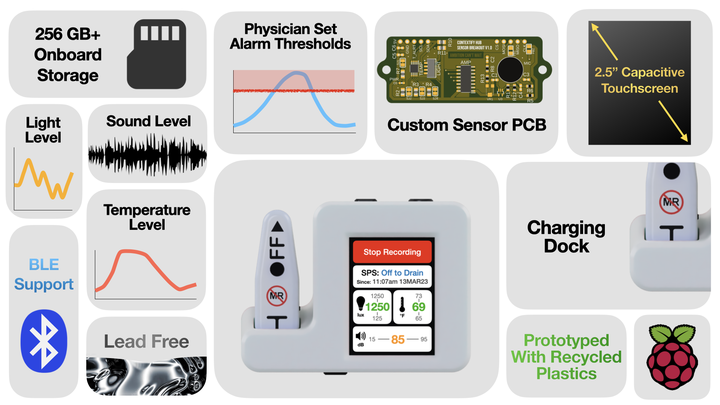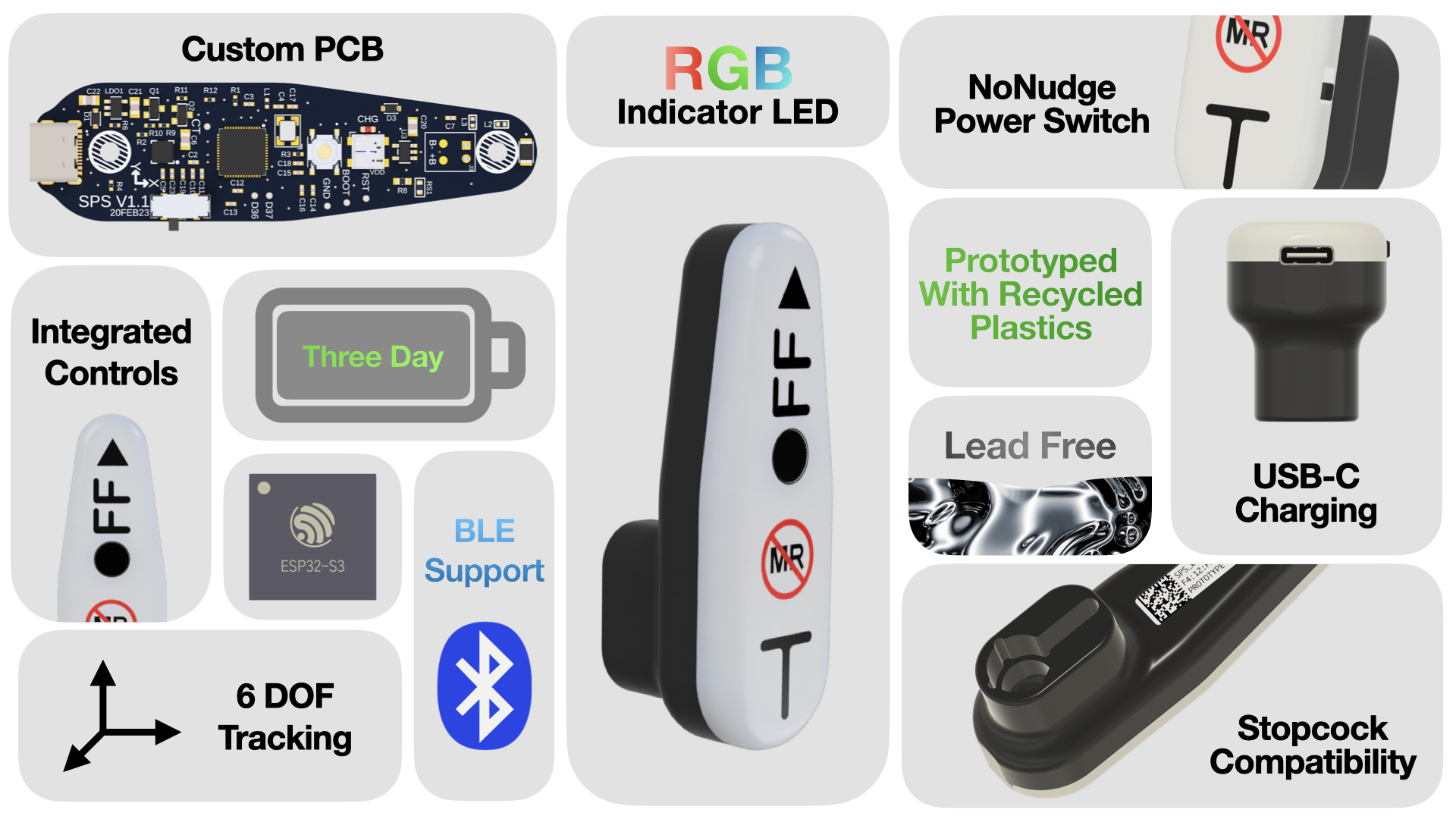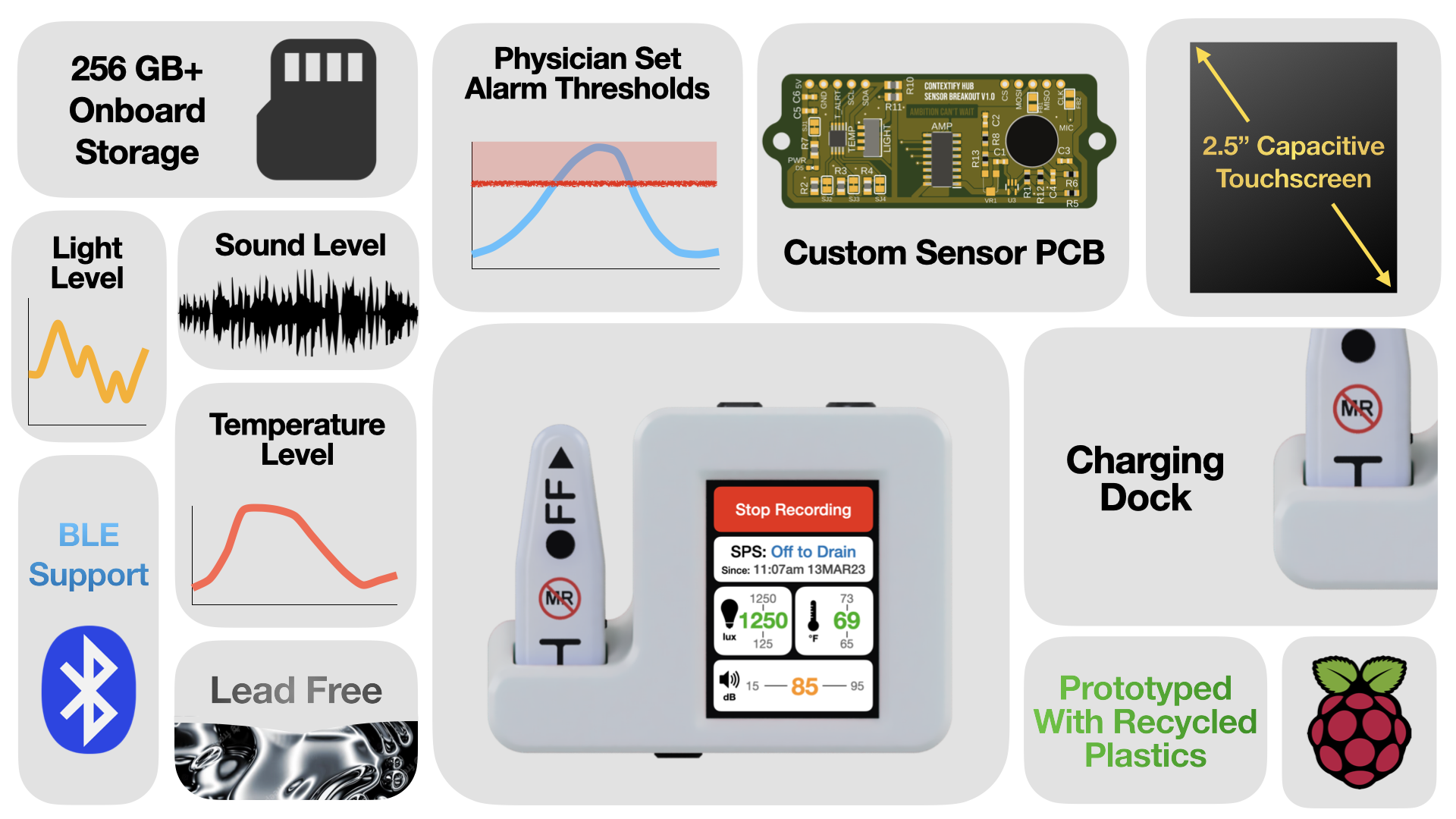The ContextifyHub

I’m proud to present the conclusion of my team’s senior design project: The ContextifyHub. We were recently honored with 2nd place in the Drexel University School of Biomedical Engineering, Science and Health Systems Senior Design Competition and are incredibly proud to announce our solution is currently being evaluated in a clinical trial at UT Southwestern Medical Center!
See below for a short summary of features included in the system:


Check out our project summary video here (3-mins):
Our novel solution, The ContextifyHub, allows clinicians and researchers to track and quantify the effects of ‘contextual factors’ on patient outcomes for the first time, enabling advanced research and development of standardized care practices for brain injury.
In it’s initial form our system generates a data-stream containing EVD stopcock position, temperature, light, and sound levels that can be integrated into existing hospital workflows and displayed alongside the patient’s physiological parameters, giving much needed context. The ContextifyHub is designed to be unobtrusive in the neuroICU yet offer convenience in its operation. It allows users to quickly engage with the device through the capacitive touchscreen and intuitive user interface, enabling them to maintain their focus on patient care.
This project has been incredibly fulfilling, allowing me to grow my experience in PCB layout, software development, mechanical design and much more. A hard project is always the best way to learn in my experience, and this challenge certainly fit the bill. After countless hours, more than 30 prototypes and thousands of lines of code we have a working device which is being tested clinically and shows promise for commercialization!
Thanks to the other members of my team: Victoria Gruen, Joshua Jose, and Kacie Wheeler for their hard work bringing this system to life. Special thanks to the Moberg Analytics team as a whole, especially Dick Moberg who served as our industry advisor as well as DaiWai Olson who has given the team some great feedback while trialing our devices. Last but certainly not least, thanks to Zack Goldblum for completing the initial proof of concept that our team was able to use as a springboard!
Project Objective
A suitable method for tracking EVD stopcock usage, environmental factors, and patient interventions, collectively known as ‘contextual factors’, must be developed. A device capable of recording these factors will facilitate multimodal patient research efforts and will allow for the optimization of standard clinical practices. This project is a continuation of work begun by our industry collaborator, Moberg Analytics. An initial breadboard prototype was created by Moberg Analytics to evaluate the usefulness of recording stopcock positional data in the clinic using an accelerometer [16]. Our project built upon this initial feasibility study to develop a neuroICU-ready system that includes an updated stopcock position sensor (SPS) and hub with entirely new hardware and software, including custom PCBs, a touchscreen UI, and integration of light, sound, and temperature sensors.
Our novel solution, The ContextifyHub, allows clinicians and researchers to quantify the effects of contextual factors on patient outcomes for the first time. Research on these factors will facilitate the development of necessary standard clinical practices, particularly with respect to ICP pressure management [17]. Additionally, our solution expands the use of digital healthcare infrastructure, thanks to its low cost and lack of interference with current clinical workflows, thus increasing the likelihood of adoption by clinicians. Our innovative modular design advantageously allows for additional inputs in the future as new factors of interest present themselves in the ever-evolving world of healthcare.
We were fortunate to receive direct clinical input from several healthcare practitioners throughout this project, ensuring we were safely and effectively meeting their clinical needs. Those conversations, in addition to feedback from the feasibility study, were pivotal in determining our scope and direction. Our solution bridges the aforementioned gaps in clinical workflows by incorporating automated environmental data logging to provide more information for patient care. We endeavored to produce a data-stream containing EVD stopcock position, temperature, light, and sound levels that could be integrated into Moberg Analytics’ multimodal bedside monitor—The CNS Monitor—and displayed alongside the patient’s physiological parameters. The ContextifyHub is designed to be unobtrusive in the neuroICU yet offer convenience in its operation. It allows users to quickly engage with the device through the capacitive touchscreen and intuitive user interface, enabling them to maintain their focus on patient care.
[16] Z. Goldblum, V. Gruen, D. Olson, G. Kanter, and D. Moberg, “A Novel External Ventricular Drain Sensor to Improve Acquired Brain Injury Monitoring,” MHSRS Supplement to Military Medicine, 2022. To be published.
[17] C. Earthman, K. Siaron, J. Wilson, and D. M. Olson, “Predictive Values for Time from Transducer Stopcock Closure to Accurate Intracranial Pressure Reading,” Neurocritical Care, vol. 38, no. 2, pp. 422-428, 2023/04/01 2023, doi: 10.1007/s12028-022-01581-5.
